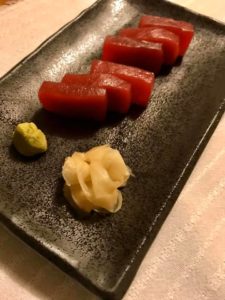Japanese cuisine differs from other cuisines in the world in that the food is very “clean”.
This applies from everyday food to fine dining.
In Japanese cuisine, the ingredients are prepared as little as possible.
To highlight the unique flavors and aromas of the ingredients, the way you use the knife is crucial to how tasty the dish ends up being.
This means that there are other requirements for the way you use your knife. In Japan, your knife can be used in many thousands of different ways; it is the raw materials in question that determine which technique to use.
The fewer raw materials used in a dish, the more important it is that knife techniques are used, made as “clean” as possible, i.e. do not make notches or marks in the raw materials in order to get the full benefit of the raw materials.
At Sushi course for beginners, you will be introduced to the most commonly used Japanese knife techniques.
_
Zoë has lectured and held sushi courses for A. P. Moller – Maersk, Hugo Boss Nordic, Novo Nordisk, Novartis, Velux, Gorrissen Federspiel, Beierholm revision, Elbek & Vejrup and many more.





